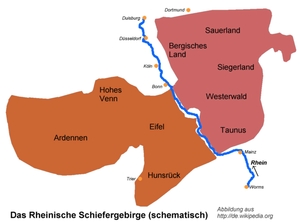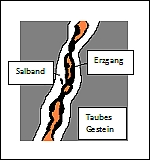The Siegerland is part of the “Rhenish Slate Range“ which the Eisernhardt belongs to. Its rocks were formed 420 to 250 million years ago. At that time the surface of the earth was in big motion. Oceans sank down, landscapes were flooded, and rocks were pushed together, cramped and overlapped like shingles on a roof. Fissures and cracks were formed. Hot water entered these caves with high pressure. The water contained several minerals and even metal salts in high concentration. The solution of those salts cooled down and crystals were formed. Thus vein deposits were generated. They contain a lot of minerals and so mining is profitable. Vein deposits usually are flat and lens-shaped and clay walls of quartz crystal separate them from the surrounding barren measure.
In the middle ages people could only detect vein deposits when they found the so called outcrop. An outcrop was generated at the surface of an ore vein by weather conditions. Oxidation changed the original minerals to new ones, which could be dissolved in water and flushed out. Ore deposits often contained minerals of iron. By weathering they changed to some oxygen compounds of iron with their typical red colour of rust. This sort of outcrop was called „Iron Hat“. Thus, special colours of boulders in a stream bed pointed to an ore deposit as well as indicator plants did.




